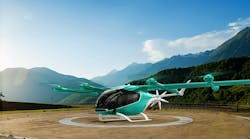By J.R. Wilson
LAS VEGAS — The Pentagon's dependence on commercial electronics development grows daily as military leaders seek to lay the foundation for next-generation advanced systems. With this in mind, what transpires at the annual Consumer Electronics Show (CES) in Las Vegas takes on new meaning.
At least two appliance manufacturers were touting their vision of the networked kitchen, where everything from the toaster to the microwave to the coffeemaker to the refrigerator was part of a Web-linked network. The combination of small, fast processors, sensors, and communications components that allow kitchen appliances to share information with each other and with outside sources — such as monitoring consumption rates and placing an electronic order for butter with a local grocer who delivers — is not difficult to transform into a military logistics scenario, in which butter literally becomes guns and the grocer a rear echelon weapons depot.
Central to giving small devices unprecedented computing power is a small form factor on which to store programs and data. Toshiba America of Irvine, Calif., set a new standard at CES with the release of a new 4-gigabyte hard-disk drive measuring only 0.85 inches in diameter and weighing less than 10 grams. Operating specs include 3600-rpm rotational speed and shock tolerance to 1000 gs. While touting the postage stamp–sized HDD for mobile phones, PDAs, digital watches, and other consumer products, it's potential for smart weapons, Land Warrior–style data storage, and communications and logistics support is equally obvious.
If space is not that critical, expanding to 1.8-inch diameter offers a line of miniature drives with capacities of as much as 40 gigabytes. Weighing only 62 grams, Toshiba's 4200-rpm MK4004GAH embedded hard drive boasts a 15-microsecond average seek time, 100-megabytes-per-second Ultra DMA transfer rate, 300,000-hours mean time between failures, and nonoperating temperature range of –20 to 65 degrees Celsius.
Also making news on the small-memory front was SanDisk of Sunnyvale, Calif., with the release of a 2-gibabyte Memory Stick Pro and 512-mgabyte MS Pro Duo card, which is roughly half the size of the Stick and SanDisk's first offering of that design. Combined with the company's earlier announcement of the Ultra II line of CompactFlash (CF) and SD flash memory cards, with minimum write speeds of 9 megabytes per second and minimum read speeds of 10 megabytes per second, these products, designed for consumer digital cameras and recorders, offer similar new capabilities to military users.
Fast read/write speeds and high memory capacity mean a sensor could acquire more data more quickly and transmit it in far less time than today's sensors can, offering potentially significant new avenues of development for miniaturized sensors.
The military calls on a wide range of power sources, including commercial batteries. As with civilian users, they often find the useful life of even "super-charged" AAA, AA, A, D, and C batteries are too short for the task at hand. Carrying large numbers of replacement batteries quickly becomes a problem, as does disposing of dead batteries.
A step in the right direction, at least for systems using standard batteries, was the CES introduction of a new line of Energizer Lithium AAA batteries by Eveready of St. Louis. Those join Eveready's previously released Lithium AAs, which company officials claim have as much as seven times the life — and one-third the weight — of traditional alkaline batteries while operating in temperatures from –40°C to 60°C.
One device the inventor claims already has attracted military interest is, at first glance, a takeoff on the Segway Human Transporter, the odd two-wheel personal stand-up scooter. The "Q" Personal People Mover from Global Manufacturing Group's Rad2Go Division in Vista, Calif., sports dual oversized wheels like the Segway, but it also has two small rear wheels, giving its larger platform far greater stability — and more standing area.
Though similar in appearance to the Segway, the motorized Q, which also doubles as a dolly, actually has more in common with a bicycle in terms of controls. Instead of leaning to move forward or back, the Q uses handlebar grip controls and a thumb throttle; the rear wheels provide steering and brakes. Dual 150-watt electric hub motors engineered into the alloy wheels give it a top speed of 10 miles per hour and it can travel as far as 15 miles on one charge of its quick-charge battery.
Inventor and company president John Wang says the military sees the Q (priced at about one-quarter the cost of a Segway) as an inexpensive way for individuals to move quickly around a facility without taking a Humvee or other vehicle away from more size-intensive tasks.
Another new device with potential military application is a 2-ounce full-page portable scanner from Planon System Solutions in Mississauga, Ontario. The wireless DocuPen — 8 inches wide and only 1/2 inch thick — can scan a full page of text or graphics in 4 seconds and hold as many as 100 pages in its 2-megabyte Flash Memory.
Working in 100- and 200-dot-per-inch modes and fitted with serial and USB connectors and a Twain interface, it can create e-mail attachments of documents that otherwise would have to be faxed or mailed, as well as make quick (and, with its accompanying optical character reader software, editable) copies of manuals, instructions, orders, and other documents.
BravoBrava of Union City, Calif., debuted a product with personal and professional potential for military personnel. A combination of software and Web-based services, AllMiMedia enables a user to access any digital content stored on any Internet-connected device using any other such device, such as a PDA or cell phone.
Walking through a cutting-edge technology showcase such as CES or its computer-centric cousin, COMDEX, and viewing the exhibits from a military perspective quickly reveals how important commercial technology is and will continue to be for defense applications. All the more so when it is also clear how those same devices can — and probably will — be used by current and future adversaries.


